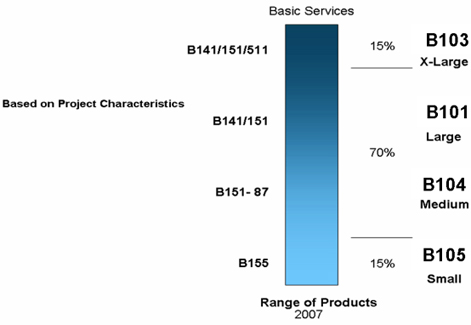
AIA Contract Documents® 2007 Update: The AIA Owner/Architect Agreements Summary: Projects come in many sizes: from simple additions to existing buildings to large, complex projects involving multiple bid packages and fast track schedules and everything in between. So why has the AIA traditionally published only a limited number of standard form Owner/Architect agreements to serve the full range of project complexity? In the November 5 release of updated 2007 documents, the AIA has acknowledged this conundrum and is providing options that allow architects and owners to select among several Owner/Architect agreements, each individually crafted to respond to a project’s complexity. Following are the major updates related to the 2007 Owner/Architect Agreements. Agreements based on project size and complexity
It is reasonable to conclude that the requirements of Owner/Architect agreements would vary based on the level of complexity of the project. For example, a very large project with multiple bid packages would require different services from the architect than would an addition to a small house. However, the 1997 versions of the B141 and B151 were serving all projects from fairly small to quite large and complex. In fact, the AIA’s Large Firm Roundtable reported that their clients would very seldom agree to use B141, opting instead to modify B151. Nor did the AIA publish an agreement specifically crafted to serve the midsize project market. Although the B155-1997 served the small-project market, members of the Small Project Practitioners Knowledge Community observed that their clients didn’t like the “small project” label. (To them, their projects weren’t small.) They also objected to the formality of the AIA’s standard contract form.
The 2007 updates introduce a series of Owner/Architect agreements designed to respond to a project’s size or complexity. B101-2007, designed to replace both B141-1997 and B151-1997 in content, was developed first. Then, to ensure consistency among all the Owner/Architect agreements, B101 was modified to create the other B-series documents. B103-2007 is designed for use on large or complex projects and was developed with input from the Large Firm Roundtable. B104-2007 is designed for projects of limited scope to serve better the midsize to small project. B105-2007, an extremely pared down version of B101, represents a complete revision of the B155-1997. Its formatting has been simplified and its new title suggests its appropriateness for residential or small commercial projects. Document format When revising B141–1997 for release in 2007, the AIA found that although the document served the interests of the specialist architect, it created undue complexity for the architect providing traditional design and contract administration services. Those architects and their clients had gravitated toward using B151™–1997, a one-part agreement for traditional services (modeled after B141–1987). Recognizing the validity of that choice, the AIA developed B101™–2007, a one-part document that consolidates and replaces B141–1997 and B151–1997. Two-part agreements still are a good idea for specialized architectural services and are still possible in the 2007 program. B102, which replaces B141 part 1, was created by dividing B101 into two parts to segregate out any text referring to services for design and construction contract administration. Those services are now found in B201™–2007. Because B102 is an agreement without a scope of services, it can then be paired with any scope-of-services document, including the 11 the AIA publishes, or a custom scope of services the owner or architect prepares. The revisions presented in the next part of this article represent some of the more significant and most hotly debated changes. They all are products of the AIA’s extensive efforts to seek, review, analyze, and discuss industry feedback from all parties whose interests may be significantly affected by individual agreements. As a result, the AIA A201–2007 Family continues the AIA’s tradition of producing agreements that fairly balance divergent interests and accurately reflect the modern construction industry. Click here to read about significant changes to the Owner-Architect Agreement. |
||
Copyright 2007 The American Institute of Architects. All rights reserved. Home Page |
||
home
news headlines
practice
business
design
recent related
› 2007 Update to AIA Contract Documents Includes Changes to A201™
Click here to read about significant changes to the Owner-Architect Agreement.
For more information on the AIA Contract Documents, visit AIA.org.

